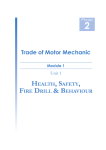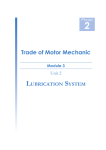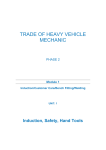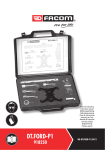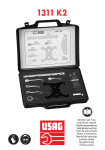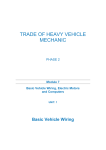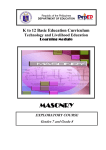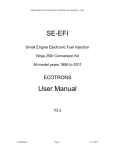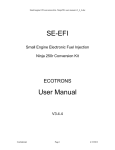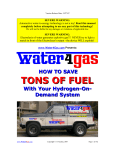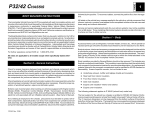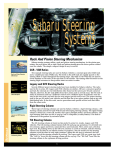Download Trade of Motor Mechanic Module 5
Transcript
Phase 2 Trade of Motor Mechanic Module 5 Unit 2 Electronic Fuel Injection Produced by In cooperation with: Subject Matter Experts Martin McMahon & CDX Global Curriculum Revision 2.2 16-01-07 © SOLAS 2013 Module 5 - Unit 2 Electronic Fuel Injection Table of Contents Introduction......................................................................................................... 1 Unit Objective...................................................................................................... 2 1.0 Health, Safety Procedures........................................................................ 3 1.1 Health and Safety........................................................................... 3 1.2 Fluoroelastomers Explained.......................................................... 4 2.0 Petrol Fuel Fires Extinguishers................................................................ 5 2.1 Petrol fire Classification................................................................. 5 3.0 Intake Air Filtration and Element Replacement...................................... 6 3.1 Air Supply....................................................................................... 6 3.2 Air Cleaners.................................................................................... 7 3.3 EFI Air Cleaners............................................................................ 8 4.0 Servicing Air Filter Elements................................................................... 9 5.0 Terms Used with Petrol Fuel Injection Systems...................................... 9 5.1 Petrol Fuel Injection Categories.................................................... 9 5.2 Modes of EFI...............................................................................12 5.3 Simultaneous Injection.................................................................13 6.0 Primary Sensor Information in the Petrol Fuel Injection ECU..............15 6.1 Mass Airflow Sensor......................................................................15 6.2 Manifold Absolute Pressure Sensor..............................................16 6.3 Tachometric Relay........................................................................17 6.4 Temperature Sensor......................................................................18 6.5 Cold Start Systems........................................................................19 6.6 Fuel System Sensor...................................................................... 20 6.7 Throttle Position Sensor...............................................................21 6.8Injectors........................................................................................21 6.9 Idle Speed Control Systems......................................................... 22 6.10 Exhaust Gas Oxygen Sensor........................................................ 23 6.11 Crank Angle Sensor...................................................................... 24 7.0 Injection System ECU Signals................................................................ 25 8.0 Electronic Single Point Petrol Fuel Injection......................................... 26 9.0 Electronic Multipoint Petrol Fuel Injection........................................... 26 10.0 Resistance of an Electronic Fuel Injector.............................................. 27 10.1 Sample Test Procedure................................................................ 27 11.0 The European On Board Diagnostics System....................................... 29 11.1 European On-Board Diagnostics (EOBD)................................. 29 12.0 Scan Tool Data........................................................................................ 30 12.1 Obtaining & Interpreting Scan Tool Data.................................. 30 13.0 Measuring Injector Pulse Duration with Oscilloscope.......................... 33 13.1 Injector Pulse Duration............................................................... 33 14.0 Using an Oscilloscope............................................................................ 34 Self Assessment................................................................................................. 35 Suggested Exercises.......................................................................................... 38 Training Resources............................................................................................ 38 Task Sheets........................................................................................................ 39 Obtaining & Interpreting Scan Tool Data............................................. 39 Suggested Further Reading................................................................................41 Trade of Motor Mechanic - Phase 2 Course Notes Revision 3.0 November 2013 Module 5 - Unit 2 Electronic Fuel Injection Introduction There are 3 Units in this Module. Unit 1 focuses on Fuel Supply System, 2 on Electronic Fuel Injection and 3 on Emissions. Module 5 Petrol Fuel Injection Unit 1 Fuel Supply System Unit 2 Electronic Fuel Injection Unit 3 Emmissions Module 5 of this course covers the Petrol Fuel Injection aspect of automotive technology. This is the second unit in module 5 and introduces the Electronic Fuel Injection. Fuel injection is a technology used in internal combustion engines to mix the fuel with air prior to combustion. A fuel injection system forces the fuel through nozzles under pressure to inject the fuel into the air stream. The components and primary sensor information related to the Electronic Fuel Injection system will be covered in this unit. Health and safety issues related to this unit will also be covered. Trade of Motor Mechanic - Phase 2 Course Notes 1 Revision 3.0 November 2013 Module 5 - Unit 2 Electronic Fuel Injection Unit Objective By the end of this unit each apprentice will be able to: • State and apply the health, safety and precautionary procedures applicable to working on petrol fuel injection systems • Identify the correct fire extinguishers required for various types of petrol fuel fires • State the purpose of intake air filtration and explain the need for regular element replacement • Remove, check and replace air filter elements • List the terms used to classify/categorise petrol fuel injection systems • Identify the primary sensor information required by the petrol fuel injection ECU • Classify each injection system ECU signal as an input or output signal • Outline the structure and fundamental operating principles of electronic single point (throttle-body) petrol fuel injection • Outline the structure and fundamental operating principles of electronic multipoint petrol fuel injection systems • Measure the electrical resistance of an electronic fuel injector and compare it with the manufacturer's specifications • State the purpose of the European On Board Diagnostics (EOBD) system • Use an appropriate code reader/scan tool to interrogate a vehicle fault code memory to ascertain the presence of Diagnostic Trouble Codes (DTCs) and erase the fault memory • Use an oscilloscope to observe/display and interpret the changes in injector pulse duration during various engine operating conditions and temperatures • Use an oscilloscope to observe/display the waveforms associated with components of the petrol fuel injection system Trade of Motor Mechanic - Phase 2 Course Notes 2 Revision 3.0 November 2013 Module 5 - Unit 2 Electronic Fuel Injection 1.0 Health, Safety Procedures Key Learning Points • Health, safety procedures relating to engine operation (e.g. exhaust fume extraction and hazard from rotating components), personal and fire hazards from fuel spillage/ leakage, sparks/ignition sources (including static electricity and mobile phones) and system pressure during component removal/replacement and potential hazards associated with fire-damaged fluoroelastomer fuel hose (e.g. 'Viton®' fuel hose); precautions necessary to avoid damage to catalytic converter due to unburned fuel etc. 1.1 Health and Safety Because of the inability of humans to detect carbon monoxide (CO) by smell/taste and the cumulative effects of CO on the body/blood could lead to carbon monoxide poisoning. Tests are to be carried out in a ventilated area and the use of appropriate gas extraction equipment which is in good working order. Pressurised fuel can be sprayed out when components are being removed or replaced , this could lead to injury to eyes, face etc. also fire. Potential hazards associated with fire-damaged fluoroelastomer fuel hose (e.g. 'Viton®' fuel hose). Covered in 1.2. Instruction is given on the correct and safe method for removing and replacing components also the correct use and type of fire extinguisher. Coming in contact with engine components e.g. exhaust related parts e.g. catalytic converter when the engine is at working temperature could lead to serious burns. Instruction is given to insure that all guards are in place before starting engine and appropriate personal protective equipment (PPE) worn e.g. overalls, safety boots etc. Improper storage, leaks and spillage of fuel could lead to fire due to sparks/ignition sources (including static electricity and mobile phones) Instruction is given on the correct and safe storage of fuel (use of correct container etc.) leaks repaired and mopped as soon as they occur and disposed in an environmental friendly manner. Safety precautions need also be applied to prevent damage to the catalytic converter as un-burnt fuel will damage the unit. Trade of Motor Mechanic - Phase 2 Course Notes 3 Revision 3.0 November 2013 Module 5 - Unit 2 Electronic Fuel Injection 1.2 Fluoroelastomers Explained Fluoroelastomers are a class of synthetic rubber which provide extraordinary levels of resistance to chemicals, oil and heat, while providing useful service life above 200°C. The outstanding heat stability and excellent oil resistance of these materials are due to the high ratio of fluorine to hydrogen, the strength of the carbonfluorine bond and the absence of unsaturation. Viton® fluoroelastomer is the most specified fluoroelastomer, well known for its excellent (400°F/200°C) heat resistance. Viton® offers excellent resistance to aggressive fuels and chemicals and has worldwide ISO 9000 registration. Applications Fluoroelastomers are used in a wide variety of high-performance applications. A partial listing of current end use applications include: Automotive uses. Shaft seals, Valve stem seals, fuel Injector O-rings, Fuel hoses, in tank and quick connect, Tire valve. Safety Note: Fumes can be trapped in an enclosed area without adequate ventilation. Fire fighters should wear a self-contained breathing apparatus (SCBA) which meets appropriate standards operated in positive pressure mode and full turnout gear. Wear skin protection adequate to protect from thermal decomposition products. Use acid resistant protective clothing (capable of resisting hydrofluoric acid) to. Handle cool parts containing decomposed fluoroelastomer. Trade of Motor Mechanic - Phase 2 Course Notes 4 Revision 3.0 November 2013 Module 5 - Unit 2 Electronic Fuel Injection 2.0 Petrol Fuel Fires Extinguishers Key Learning Points • Identification of the correct fire extinguishers required for various types of petrol fuel fires 2.1 Petrol fire Classification "B" class fires involve flammable liquids such as petrol. Carbon dioxide fire extinguishers are most effective when used against “B” “C” and “E” class fires. The gas is heavier than air and provides an inert blanket that smothers the fire. A carbon dioxide fire extinguisher will spray small ice particles with the gas. This is normal. Dry Powder fire extinguishers contain a fine powder usually sodium bicarbonate held under pressure by an inert gas. The extinguisher smothers the fire with a fine powder. These extinguishers are good to fight any fuel or liquid fire. Foam fire extinguishers contain a chemical that forms a soft foam that floats over the target area and smothers the fire. Trade of Motor Mechanic - Phase 2 Course Notes 5 Revision 3.0 November 2013 Module 5 - Unit 2 Electronic Fuel Injection 3.0 Intake Air Filtration and Element Replacement Key Learning Points • Purpose of intake air filtration and the need for regular element replacement 3.1 Air Supply The air required for the combustion of the fuel is led from the air filter, through the throttle valve and into the common manifold, or plenum chamber. From here, individual intake runners, or pipes, branch off to each cylinder. All of these pipes are of equal length. Filtered air arrives at the intake port, as cold and dense as possible, ready for mixing with the fuel from the injector. It is important to check and change the air filter when necessary. A dirty air filter will restrict the air supply and affect the air fuel i.e. reduce the air fuel ratio <14.7:1. Trade of Motor Mechanic - Phase 2 Course Notes 6 Revision 3.0 November 2013 Module 5 - Unit 2 Electronic Fuel Injection 3.2 Air Cleaners An air cleaner filters air that passes through it to stop harmful particles reaching the engine. The air cleaner on a carburetted engine can be on top of the carburettor, or beside the engine, connected to the carburettor by a hose or duct. Position is usually decided by how much space there is or bonnet profile. On some electronically fuel injected engines, the air cleaner is on top of the throttle body similar to a carburettor. Other air cleaners are connected by ducts. Diesel engines often have more than one air cleaner. This may be due to their severe working conditions. They’re usually mounted away from the engine to obtain cleaner, cooler air. A lot of air passes through the intake system into the engine. In a petrol engine the ratio is 14.7:1 times the amount of fuel by weight. By volume that’s 11,000 times more air than fuel. The air-fuel mixture enters the engine so the air needs to be clean. Any abrasives that enter the engine can cause wear and damage. It also has a silencing effect muffling noise produced by the air entering the engine. It can act as a flame trap. So if a petrol engine backfires, the air cleaner can contain the flame within the intake manifold or carburettor. Trade of Motor Mechanic - Phase 2 Course Notes 7 Revision 3.0 November 2013 Module 5 - Unit 2 Electronic Fuel Injection 3.3 EFI Air Cleaners An air cleaner on a multi-point electronic fuel injected engine usually has a different shape from that on a carburetted engine but it serves the same purpose. In many vehicles, the air cleaner is mounted where it can get cool clean air. This air is then carried to the throttle body by a long flexible duct. Inside the air cleaner a filter element of pleated paper filters the air and reduces noise. Some electronically fuel-injected systems have an airflow sensor after the air cleaner element. It accurately measures all air entering the engine and adjusts the air-fuel mixture accordingly. So it’s essential there are no air leaks or it will upset this mixture. Trade of Motor Mechanic - Phase 2 Course Notes 8 Revision 3.0 November 2013 Module 5 - Unit 2 Electronic Fuel Injection 4.0 Servicing Air Filter Elements Key Learning Points • Practical Task Removal, checking and replacing air filter elements Please refer to your instructor for additional information, which is available from the automotive technical manuals. 5.0 Terms Used with Petrol Fuel Injection Systems Key Learning Points • Terms used to classify/categorise petrol fuel injection systems e.g. single-point injection (throttle-body or central fuel injection), multipoint injection (indirect/port injection), continuous injection, intermittent injection (sub-divided into simultaneous and sequential injection) and direct injection 5.1 Petrol Fuel Injection Categories 1. Single-point, central fuel injection or throttle body injection (TBI) 2. Multi-point fuel injection (MPFI) 3. Continuous injection 4. Sequential fuel injection (SFI) 5. Simultaneous injection 6. Direct injection 1 Single-Point, Central Fuel Injection or Throttle Body Injection (TBI) The earliest and simplest type of fuel injection, Electronic throttlebody injection was introduced in the early 1980s as a transition technology to fully-electronic port injection. Single-point simply replaces the carburettor with one or two fuel-injector nozzles in the throttle body, which is the throat of the engine’s air intake manifold. Trade of Motor Mechanic - Phase 2 Course Notes 9 Revision 3.0 November 2013 Module 5 - Unit 2 Electronic Fuel Injection For a number of manufacturers, single point injection although a stepping stone to the more complex multi-point system, is still used in some vehicles today. The system injects fuel into the throttlebody (a wet system), so fuel can condense and cling to the walls of the intake system. This system also resulted in harming emissions. Computer-controlled TBI was inexpensive and simple, however and lasted well into the 1990s. 2 Multi-Point Fuel Injection (MPFI) Multi-point fuel injection devotes a separate injector nozzle to each cylinder, right outside its intake port, which is why the system is sometimes called Port injection. Shooting the fuel vapour this close to the Intake port almost ensures that it will be drawn completely into the cylinder. The main advantage is that MPFI meters fuel more precisely than do TBI designs, better achieving the desired air/fuel ratio and improving all related aspects. Also, it virtually eliminates the possibility that fuel will condense or collect in the intake manifold. With TBI and carburettors, the intake manifold must be designed to conduct the engine’s heat, a measure to vaporize liquid fuel. This is unnecessary on engines equipped with MPFI, so the intake manifold can be formed from lighter-weight material, even plastic. 3 Continuous Fuel Injection System (This is a mode of injection) Continuous fuel injection systems provide a continuous spray of fuel from each injector at a point in the intake port located just before the intake valve. The entrance of the fuel into the cylinder is controlled by the intake valve. Covered in section 5.2. Intermittent Injection 4 Sequential Fuel Injection (SFI) (This is a mode of injection) Sequential fuel injection, also called sequential port fuel injection (SPFI) or timed injection, is a type of multi-port injection. Though basic MPFI employs multiple injectors; they all spray their fuel at the same time or in groups. As a result, the fuel may” hang- around” a port for as long as 150 milliseconds when the engine is idling. This may not seem like much, but it’s enough of a shortcoming that engineers addressed it: Sequential fuel injection triggers each injector nozzle independently. Timed like Spark Plugs, they spray the fuel immediately before or as their intake valve opens. It seems a minor step, but efficiency and emissions improvements come in very small doses. Trade of Motor Mechanic - Phase 2 Course Notes 10 Revision 3.0 November 2013 Module 5 - Unit 2 Electronic Fuel Injection 5 Simultaneous Injection (This is a mode of injection) In multi-point injection, the injectors can all be triggered simultaneously, twice per cycle. In a throttle-body system, the central injector is normally triggered on each ignition pulse. With 2 injectors, alternate triggering may be used. 6 Direct Injection Direct injection takes the fuel injection concept about as far as we can go, injecting fuel directly into the combustion chambers, past the valves. More common in diesel engines, direct Injection is starting to pop up in petrol engine designs, sometimes called DIG for direct injection gasoline or GDI for Gasoline Direct Injection. Again, fuel metering is even more precise than in the other injection schemes and the direct injection gives engineers yet another variable to influence precisely how combustion occurs in the cylinders. The science of engine design scrutinizes how the fuel –air mixture swirls around in the cylinders and how the explosion travels from the ignition point. Things such as the shape of cylinders and pistons; port and spark plug locations; timing, duration and Intensity of the spark; and number of spark plugs per cylinder (more than one is possible) all affect how evenly and completely fuel combusts in a petrol engine. Theory of Operation The major advantages of a GDI engine are increased fuel efficiency and high power output. This is achieved by the precise control over amount of fuel and injection timings which are varied according to the load conditions. Basically, the engine management system continuously chooses between three different modes of combustion: ultra lean burn combustion, stoichiometric combustion and high power output mode. Each mode is characterized by air-fuel ratio, the amount of fuel in the air-fuel mixture; the stoichiometric ratio for petrol is 14.7 to 1, but in ultra lean mode, it could be as high as 65 to 1, resulting in much leaner mixtures than those ever achieved in the conventional engines. Trade of Motor Mechanic - Phase 2 Course Notes 11 Revision 3.0 November 2013 Module 5 - Unit 2 Electronic Fuel Injection Ultra lean combustion mode is effective under normal conditions, when little acceleration is required. The fuel is not injected at the intake stroke but rather at the latter stages of the compression stroke, so that the small amount of air-fuel mixture is optimally stratified just below the spark plug. The initial combustion takes place in a toroidal cavity on the piston’s surface. This technique enables the usage of ultra lean mixtures with very high air-fuel rates, impossible with traditional intake valves. Stoichiometric combustion mode is activated for moderate load conditions. In this mode, fuel is conventionally injected during the intake stroke to obtain stoichiometric rates. In Full power mode, the air-fuel mixture is homogeneous and consists of maximum amount of fuel that is possible to ignite without knocking out, as defined by the compression ratio of the engine. The fuel is injected during the intake stroke. This mode activates at high load conditions and provides maximum output and torque. 5.2 Modes of EFI A mode of injection describes the timing and the sequence of injecting fuel. Simultaneous injection means, every injector opens at the same time. Fuel sprays into each intake port where it stays until the inlet valve opens. During each engine cycle, the injectors open twice and each time they deliver half the fuel needs of each cylinder. This happens regardless of the position of the intake valve. The injectors are triggered by the ignition system. On a 6-cylinder engine the control unit triggers the injectors on every third ignition pulse. Trade of Motor Mechanic - Phase 2 Course Notes 12 Revision 3.0 November 2013 Module 5 - Unit 2 Electronic Fuel Injection Sequential injection means injection for each cylinder occurs once per engine cycle. It is timed to each individual cylinder in the firing order. Fuel spray stays in the intake port until the inlet valve opens. Grouped injection divides the injectors into 2 groups. A 6-cylinder engine can have injectors 1, 2 and 3 in group 1 and injectors 4, 5 and 6 in group 2. The control unit operates the groups in turn, to spray fuel once per engine cycle. Group 1 injects then 360° or one crankshaft rotation later so does group 2. This happens Regardless of the position of the intake valve. Just one injection provides the full quantity of fuel for each cylinder during that engine cycle. In some applications, different modes of injection are combined, so that the mode changes according to the operating conditions. Sequential mode may be used for low engine speeds, changing to simultaneous mode at high speeds. The same principle is used in changing from light loads to heavy loads. Similarly, the mode may change from group injection, to simultaneous. Using different modes for different operating conditions make the most of how the fuel is used and that improves power output, fuel economy and emission control. 5.3 Simultaneous Injection In multi-point injection, the injectors can all be triggered at the same time. This is called simultaneous injection and the injectors operate twice per cycle. That’s once each crankshaft revolution, each time delivering half the fuel for the cycle. In a 6-cylinder engine, the injectors are triggered on every third ignition pulse. In throttle-body systems; the central injector is normally triggered on every ignition pulse. However, if there are 2 injectors, alternate triggering may be used. Trade of Motor Mechanic - Phase 2 Course Notes 13 Revision 3.0 November 2013 Module 5 - Unit 2 Electronic Fuel Injection At idling speeds, the frequency may be less, to provide finer control. The actual operating time of the injectors depends very much on battery voltage. The response time to lift the injector needle to the fully-open position is about 1 millisecond. If battery voltage is low this response time takes longer and the engine receives less fuel. The ECU can compensate for this delay in opening time by extending the duration of the injection pulse. In more sophisticated engine management systems, the control unit can control additional functions such as ignition timing, injection modes, idle speed, cooling fans and fuel pump operation. To do this however, more inputs are needed. To control ignition timing, some systems replace the distributor with a direct-fire ignition system. Between one ignition point and the next, the ECU calculates when the ignition point will occur. It then triggers the ignition accordingly. Ignition can be varied according to load, speed, coolant temperature, cranking speed and battery voltage. Identifying number one cylinder and the camshaft position, allows different injection modes to be used. Sequential injection means injection occurs in the sequence of the firing order. Each injector opens once only in each cycle, to deliver the fuel needed. Added load placed on the engine during idle, can be compensated for by increasing the passageway of an idle speed control device. This lets more air by-pass the throttle plate. This air has been measured by the airflow meter, so extra fuel is metered to maintain the same air-fuel ratio. The extra mixture thus delivered increases engine torque and maintains idle speed. Trade of Motor Mechanic - Phase 2 Course Notes 14 Revision 3.0 November 2013 Module 5 - Unit 2 Electronic Fuel Injection 6.0 Primary Sensor Information in the Petrol Fuel Injection ECU Key Learning Points • Primary sensor information required by ECU e.g. engine load (air flow metering with air temperature correction to convert air volume to air mass and air mass metering without temperature correction), engine speed and coolant temperature 6.1 Mass Airflow Sensor The mass type airflow sensor detects the mass of air flowing into the intake manifold. By measuring the mass of the air, it prevents changes in air density affecting the air-fuel mixture. The airflow meter has an electrically-heated wire, mounted in the air stream. A control circuit is linked to the wire and current is supplied to the wire to keep its temperature constant. The higher the airflow the more the temperature of the wire falls - and the higher the current needed in the wire to keep its temperature constant. So how this current varies is a measure of what is happening to the air flow. Trade of Motor Mechanic - Phase 2 Course Notes 15 Revision 3.0 November 2013 Module 5 - Unit 2 Electronic Fuel Injection Current flow variation is then read as an output voltage and converted by the ECU to an intake air signal. This determines the basic fuel quantity needed for injector pulse duration. The airflow meter can have a self-cleaning function that burns dust and other contaminants from the hot wire. This is done by the control unit heating the wire to 1000°Celsius for approximately 1 second. This happens 5 to 10 seconds after the ignition is switched off. This function operates only when certain conditions have been met. For this vehicle, the engine must have reached operating temperature and the vehicle must have been travelling above 10 kilometres an hour or above 6.2 miles per hour. In some types of sensors, the hot wire is mounted in a sub passage connected to the main passage. This allows maximum airflow through the main passage. The hot wire may be sealed in a glass envelope. This protects the wire and eliminates the need for burnoff. In others, the heating element is a ceramic plate. 6.2 Manifold Absolute Pressure Sensor Changes in engine speed and load, cause changes in intake manifold pressure. This sensor measures these pressure changes and converts them into an electrical signal. It’s called a manifold absolute pressure, or MAP, sensor. The signal may be an output voltage, or a frequency. By monitoring output voltages, the control unit senses manifold pressure and uses this information to provide the basic fuel requirement. It can use a piezoelectric crystal. If there is a change in the pressure exerted on this crystal, it changes its resistance. This alters its output signal. Trade of Motor Mechanic - Phase 2 Course Notes 16 Revision 3.0 November 2013 Module 5 - Unit 2 Electronic Fuel Injection The sensor is connected to the intake manifold by a small-diameter, flexible tube. The control unit sends a 5 volt reference signal to the sensor. As manifold pressure changes, so does the electrical resistance of the sensor and this in turn produces change in the output voltage. During idling, manifold pressure is low, which produces a comparatively low MAP output. With wide open throttle, manifold pressure is closer to atmospheric, so output is higher. 6.3 Tachometric Relay A tachometer is used to indicate engine RPM. Rev Counter It is normally connected to the negative terminal of the ignition coil. The pulses from the ignition primary circuit are then used as an input to operate the tachometer. At idle speed, the frequency of the pulse is steady. As the engine speed rises, the frequency of the pulse increases, as the tachometer indicates. As a safety measure, the tachometric relay uses an input (from the negative side of the ignition coil) to ensure the relay operates only when engine speed is above a specified minimum, approx. 350 RPM. In this way it can operate as a safety device, ensuring for instance that the fuel pump operates only when the engine speed exceeds this figure. Trade of Motor Mechanic - Phase 2 Course Notes 17 Revision 3.0 November 2013 Module 5 - Unit 2 Electronic Fuel Injection 6.4 Temperature Sensor To maintain the air-fuel ratio within an optimum range, the control unit must take account of coolant temperature and air temperature. Extra fuel is needed when the engine is cold and when the air is colder and therefore denser. The coolant temperature sensor is immersed in coolant in the cylinder head. It consists of a hollow threaded pin which has a resistor sealed inside it. This resistor is made of a semiconductor material whose electrical resistance falls as temperature rises. The signal from the coolant temperature sensor is used to control the mixture enrichment when the engine is cold and is processed in the control unit. Enrichment occurs during engine cranking and then slowly reduces he engine warms up. This ensures a steady engine response immediately after releasing the starter. The control unit continually monitors coolant temperature during engine operation. If the air temperature sensor is installed in the airflow sensor, it’s positioned in the air stream and it’s called an intake air temperature sensor or IAT. When it’s installed in the intake manifold it’s located in one of the intake runners and it’s called a manifold air temperature sensor, or MAT. In both cases it relays information on temperature and therefore the density of the air. The control unit can then vary the setting accordingly. Trade of Motor Mechanic - Phase 2 Course Notes 18 Revision 3.0 November 2013 Module 5 - Unit 2 Electronic Fuel Injection 6.5 Cold Start Systems When a cold engine starts, some of the fuel injected by the main injectors condenses on the cold intake port or the cylinder walls. Less fuel stays mixed with the air, which weakens the mixture. To overcome this and ensure a rapid start, an extra supply of fuel must be provided. Extra fuel can also come from a separate cold-start injector, normally mounted centrally on the plenum chamber. It’s supplied with fuel under pressure from the fuel rail and only operates when the engine is cranking. A switch called a thermo time switch immersed in engine coolant, completes the electrical circuit. It controls the operation, according to engine temperature. This ensures the injector operates under cranking conditions only when the engine is actually cold. The control unit can help cold-starting and provide cranking enrichment by increasing the pulse width of the injectors. This is in addition to the cold-start injector operation and is again temperature-controlled. Some sequential systems use a pre-injection of fuel. This means all injectors open simultaneously, to provide an initial injection of fuel. This happens only during cold cranking and there is a time delay, to prevent pre-injection occurring again within a certain time if the engine does not start. The system reverts to sequential injection when the engine starts. Trade of Motor Mechanic - Phase 2 Course Notes 19 Revision 3.0 November 2013 Module 5 - Unit 2 Electronic Fuel Injection 6.6 Fuel System Sensor An air flow meter varies its signal by the deflection of a vane as air enters the engine. Deflecting the vane moves contacts across a potentiometer to signal its position and thus the amount of air entering the system. The temperature sensor uses material with a negative temperature coefficient of resistance. Its resistance is high when it’s cold, but it falls as its temperature rises. It is called a thermistor. This is the opposite of a normal resistor, which increases its resistance as temperature rises. The coolant temperature sensor is immersed in coolant, in the cylinder head. The air temperature sensor is in the air intake - at the airflow meter, or in the manifold. Throttle position can be signalled by a potentiometer attached to the throttle shaft. It provides a continuous, varying signal, through the entire range of throttle position. Throttle position can also be signalled by a contact-type switch, but it signals the idle and fully open positions only. Engine speed can be detected by a connection from the ignition system primary circuit, or by a pulse generator-type sensor, on the crankshaft. The pulses are computed by the control unit, into an engine RPM figure. They can also be used to trigger the injectors. Trade of Motor Mechanic - Phase 2 Course Notes 20 Revision 3.0 November 2013 Module 5 - Unit 2 Electronic Fuel Injection 6.7 Throttle Position Sensor This sensor gathers information on throttle positions, to allow the control unit to make adjustments according to operating conditions. It is located on the throttle body and operated by rotation of the throttle spindle or shaft. Throttle position is sensed by a contact type switch, or a potentiometer. The switch type has 2 contacts - idle full load. It can be supplied with a voltage to the centre terminal of its connector. 6.8 Injectors The injector used for throttle-body injection is similar to that used for multi-point. It has a nozzle and spring-loaded plunger, operated by a solenoid. When the injector opens, fuel is sprayed into the intake air passing through the throttle body. In some cases, a cold-start injector is fitted. It is a solenoid-operated valve, on the intake manifold or plenum chamber. It is in the main air stream, on the engine side of the throttle butterfly and it’s supplied with fuel under pressure from the fuel rail. The operation is controlled by the action of a thermo time switch. The exact injector open time depends on the data the sensors give the ECU. The injector is supplied with constant live via the fuel pump relay. The engine control operates the injector by the means of turning off and on the earth circuit in quick succession. It provides pulses of a set duration, so that the injector valve opens and closes, or pulses, very quickly. Electrical pulses pass through the injector winding and set up a magnetic field that draws the plunger and valve away from the nozzle seat. This function is known as pulse with modulation (PWM). The PWM is responsible for the amount of fuel injected. This can be measured with an oscilloscope and comparing the reading to the Autodata® value. Trade of Motor Mechanic - Phase 2 Course Notes 21 Revision 3.0 November 2013 Module 5 - Unit 2 Electronic Fuel Injection Fuel held under pressure in the fuel rail can now pass through the filter and the centre of the injector and enter the inlet port. When fitting injectors it is important to fit a new “o” ring (seal) at the base of the injector. 6.9 Idle Speed Control Systems If more loads are put on the engine during idle, its idle speed may fall to a level where the engine stalls. Higher load can be caused by extra frictional resistance that occurs in a cold engine and by electrical loads from headlights or the cooling fan. The extra air needed for a cold engine can come from an Auxiliary Air Device. Some have a connecting hose from the intake air side to its controlling passageway and a return hose to the plenum chamber. It bypasses the throttle plate when it is operation, to provide the extra air. The control unit reacts to this additional air by metering additional fuel. This makes more air-fuel mixture available during the warm-up period. Trade of Motor Mechanic - Phase 2 Course Notes 22 Revision 3.0 November 2013 Module 5 - Unit 2 Electronic Fuel Injection How much air bypasses the throttle plate can be controlled automatically by the ECU. It receives data on idle speed and idle conditions and uses it to provide an output to a solenoid-operated taper valve, or to a stepper-motor pintle. The valve varies the opening of the bypass passageway and changes the idle speed to suit. The position of the throttle plate can control idle speed automatically. A D-C motor works a plunger in contact with a lever, attached to the throttle spindle. As idle conditions change the control unit can extend or retract the plunger, which increases or decreases the throttle plate opening. This provides the desired idle speed. If the control unit is programmed to maintain a fine control of the idling speed - perhaps to within 100 RPM - ignition timing can be used. Advancing the ignition point increases engine speed, just as retarding it decreases it. 6.10 Exhaust Gas Oxygen Sensor The oxygen sensor, also called a lambda sensor is mounted in the exhaust manifold. Its sensing portion is exposed to the stream of exhaust gas. It detects left-over oxygen in the exhaust gas and sends the data to the control unit. The control unit uses it to fine-tune the pulse it sends to the fuel injectors. Trade of Motor Mechanic - Phase 2 Course Notes 23 Revision 3.0 November 2013 Module 5 - Unit 2 Electronic Fuel Injection 6.11 Crank Angle Sensor Crank Angle Sensing uses information on the speed and position of the crankshaft to control ignition timing and injection sequencing. The control unit can then trigger the ignition and injection, to suit operating conditions. Crank Angle Sensor The position sensor may be mounted externally on the crankcase wall or it may be inside the housing of the ignition distributor. Trade of Motor Mechanic - Phase 2 Course Notes 24 Revision 3.0 November 2013 Module 5 - Unit 2 Electronic Fuel Injection 7.0 Injection System ECU Signals Key Learning Points • ECU input and output signal classification Trade of Motor Mechanic - Phase 2 Course Notes 25 Revision 3.0 November 2013 Module 5 - Unit 2 Electronic Fuel Injection 8.0 Electronic Single Point Petrol Fuel Injection Key Learning Points • Structure and fundamental operating principles of electronic singlepoint (throttle-body) petrol fuel injection including sensors and actuators Explained in section 5 and 6 9.0 Electronic Multipoint Petrol Fuel Injection Key Learning Points • Structure and fundamental operating principles of electronic multi-point petrol fuel injection systems including sensors and actuators Explained in section 5 and 6 Trade of Motor Mechanic - Phase 2 Course Notes 26 Revision 3.0 November 2013 Module 5 - Unit 2 Electronic Fuel Injection 10.0Resistance of an Electronic Fuel Injector Key Learning Points • Practical Task Measurement of electronic fuel injector electrical resistance and comparison to manufacturer's specifications Please refer to your instructor for additional information, which is available from the automotive technical manuals. See the following example. 10.1 Sample Test Procedure Test procedure is as follows: (Reproduced courtesy of Autodata® Ltd, Unit 5 Priors Way, Maidenhead, England) Manufacturer: Engine code: Ford EYDB Model: Ford Focus (90) 1,8 2000-05 Injectors Injector checking and cleaning: Refer to General Test Procedures. Checking Resistance Fig. 1 Technical Data Resistance 11,5Ω approx.. • Ensure ignition switched OFF. • Disconnect injector multi-plug. • Check resistance between injector terminals. Checking Supply Voltage Fig. 2 Technical Data Terminals 1 & earth Voltage Battery voltage • Ensure ignition switched OFF. • Disconnect injector multi-plugs. • Switch ignition ON. • Check voltage between harness multi-plug terminal and earth. • Repeat test for each injector Trade of Motor Mechanic - Phase 2 Course Notes 27 Revision 3.0 November 2013 Module 5 - Unit 2 Checking Signal Fig. 3 Electronic Fuel Injection 1. Ensure ignition is switched OFF. 2. Disconnect injector multi-plugs. 3. Connect LED test lamp between harness multi-plug terminals. 4. Briefly crank engine. 5. Check that LED flashes. 6. If LED does not flash; check wiring. 7. Repeat test for each injector. Trade of Motor Mechanic - Phase 2 Course Notes 28 Revision 3.0 November 2013 Module 5 - Unit 2 Electronic Fuel Injection 11.0 The European On Board Diagnostics System Key Learning Points • Purpose of the European On Board Diagnostics (EOBD) system 11.1 European On-Board Diagnostics (EOBD) EOBD A diagnostic system that is able to detect and store emission related failures. A fault in EOBD will trigger a “freeze frame” and a “TROUBLE CODE” (TC), after the correct drive cycle. In Europe the EOBD (European On-Board Diagnostics) system was mandated by European Directive 98/69/EC for all petrol vehicles made from 1 January 2001. Modern EOBD implementations use a standardized fast digital communications port to provide real-time data in addition to a standardized series of diagnostic trouble codes, or DTCs, which allow you to rapidly identify and repair malfunctions within the vehicle. Fault codes are defined by the Society of Automotive Engineers (SAE) and binding for all EOBD systems. System’s Monitored by EOBD 1. Catalytic converter efficiency 2. Misfire detection. (ignition and crank angle) 3. Fuel system 4. O2 sensors 5. (EVAP system) including tank ventilation feedback 6. EGR system 7. Tank contents (charcoal filter) 8. PCM microprocessor Trade of Motor Mechanic - Phase 2 Course Notes 29 Revision 3.0 November 2013 Module 5 - Unit 2 Electronic Fuel Injection 12.0Scan Tool Data Key Learning Points • Practical Task Use of an appropriate code reader/scan tool to interrogate a vehicle fault code memory to ascertain the presence of Diagnostic Trouble Codes (DTCs) and erase the fault memory Please refer to your instructor for additional information, which is available from the automotive technical manuals. 12.1 Obtaining & Interpreting Scan Tool Data Preparation and Safety Objective Retrieve, record and clear stored OBD I & II diagnostic trouble codes using a scan tool. Personal Safety Whenever you perform a task in the workshop you must use personal protective clothing and equipment that is appropriate for the task and which conforms to your local safety regulations and policies. Among other items, this may include: • Work clothing - such as coveralls and steel-capped footwear • Eye protection - such as safety glasses and face masks • Ear protection - such as earmuffs and earplugs • Hand protection – such as rubber gloves and barrier cream • Respiratory equipment – such as face masks etc. If you are not certain what are appropriate or required, ask your instructor. Trade of Motor Mechanic - Phase 2 Course Notes 30 Revision 3.0 November 2013 Module 5 - Unit 2 Safety Check Points to Note Electronic Fuel Injection • If the vehicle is to be run inside the workshop use exhaust extraction hoses. • Output solenoids can be energized from the scan tool, activating components without warning. It is imperative that the operator should follow the service manual procedures. • Make sure that you understand and observe all legislative and personal safety procedures when carrying out the following tasks. If you are unsure of what these are, ask your supervisor. • Make sure that you follow service manual procedures for the vehicle you are working on. • The standard procedure for retrieving codes for an OBD I vehicle, is to access the codes, write them down, clear the codes, start the vehicle and recheck for any codes that reset. • The standard procedure for diagnosing an OBD II vehicle is different as it requires that the codes should NOT be cleared until the vehicle is repaired. Clearing the codes also clears all of the freeze frame data in the system that is useful for the diagnosis process. • It may take several 'trips' for the code to reset, so with OBDII you must complete the diagnosis process first before clearing the codes. • Always check for any applicable service bulletins when diagnosing computer related problems, as they can provide valuable information about new faults that emerge on vehicles as their operational characteristics change as the vehicles get older. Trade of Motor Mechanic - Phase 2 Course Notes 31 Revision 3.0 November 2013 Module 5 - Unit 2 Electronic Fuel Injection Step-by-Step Instruction 1. Connect the scan tool: Locate the scan tool access point and connect the scan tool using the appropriate connector for the vehicle. Turn on the vehicle ignition. Turn on the scan tool. Run the scan tool diagnostic program and navigate through each of the different systems in turn to access the diagnostic trouble codes from the vehicles electronic control module. Note your findings for each vehicle system. 2. Check your findings: Look up what each code means and present the information to your supervisor. Any fault indicated by the diagnostic trouble codes will need to be corrected before you clear the codes. 3. Clear fault codes: To clear the fault codes from the vehicle; select the delete codes option on the scan tool. Check that the codes have cleared and turn off the vehicle ignition. 4. Recheck for fault codes: Turn on the vehicle ignition. Run the scan tool diagnostic program and navigate through each system again to check the codes do not reactivate. If the fault codes reactivate, take your findings to your instructor. Turn off the vehicle ignition. Turn off the scan tool and disconnect from the access point. Trade of Motor Mechanic - Phase 2 Course Notes 32 Revision 3.0 November 2013 Module 5 - Unit 2 Electronic Fuel Injection 13.0Measuring Injector Pulse Duration with Oscilloscope Key Learning Points • Use of oscilloscope to observe/display injector pulse duration 13.1 Injector Pulse Duration Note: Pulse width or pulse time - "The length of time an injector is open and squirting fuel is called the "pulse width" and measured in milliseconds (ms). Here is an example of the scope pattern. Practical Task Please refer to your instructor for additional information, which is available from the automotive technical manuals. Trade of Motor Mechanic - Phase 2 Course Notes 33 Revision 3.0 November 2013 Module 5 - Unit 2 Electronic Fuel Injection 14.0Using an Oscilloscope Key Learning Points Practical Task • Interpretation of the changes in injector pulse duration during various engine operating conditions and temperatures system • Use of data manuals/manufacturer's manuals/NCT/DoT VTM manual • Use of oscilloscope to observe/display the waveforms associated with components of the petrol fuel injection system e.g. sensors and actuators The outline of an Oscilloscope and its function is covered in Module 4 Unit 2 section 6.0. Therefore please refer to your instructor for additional information, which is available from the automotive technical manuals. Trade of Motor Mechanic - Phase 2 Course Notes 34 Revision 3.0 November 2013 Module 5 - Unit 2 Electronic Fuel Injection Self Assessment Q1: When all of the injectors operate at the same time the system is called: (Tick one box only) 1. Early 2. Sequential 3. Simultaneous 4. Grouped Q2: The purpose of the ECU is to control the ignition and fuel components on an EFI system. (Tick one box only) 1. No, the ECU only has the ability to control fuel system components only 2. No, the ECU only has the ability to control ignition system components only 3. Yes, the ECU has the ability to control a number of ignition and fuel system components including the injectors and the fuel pump during operation Q3: What is an auxiliary air valve used for in an EFI system? (Tick one box only) 1. It is used as part of the acceleration system 2. It is used as part of the de-acceleration system 3. It is used as part of the economy cruise system 4. It is used as part of a cold starting system Q4: What measures the volume of air that is taken into the engine? (Tick one box only) 1. Air flow meter 2. Air flow spectrometer 3. Air flow sensor 4. Air pressure sensor Trade of Motor Mechanic - Phase 2 Course Notes 35 Revision 3.0 November 2013 Module 5 - Unit 2 Electronic Fuel Injection Q5: Intake manifold heating is not normally used with multi-point injection because: (Tick one box only) 1. The fuel is heated by a warm-up regulator 2. The manifold carries air only 3. A plenum chamber is used for vaporization 4. Atomizing the fuel is unnecessary Q6: What is the mode of injection when injection is timed to commence at the same point in the cycle for every cylinder: (Tick one box only) 1. Simultaneous 2. Grouped 3. Sequential 4. Both simultaneous and grouped Q7: Continuous monitoring of the throttle position can be provided by a: (Tick one box only) 1. Potentiometer-type sensor 2. MAP sensor 3. Crank-angle sensor 4. RPM sensor Q8 Which throttle-plate position is more likely to cause very low manifold pressure? (Tick one box only) 1. With the throttle plate open 2. With the throttle plate closed Q9: A vehicle is using medium throttle with light loading and mild acceleration; its fuel pressure is excessive; feedback from the ECU sensor indicates a rich mixture. What is the ECU likely to do to the pulse width of the injector if all other factors stay constant? (Tick one box only) 1. Decrease pulse width 2. Increase pulse width 3. Not change pulse width Trade of Motor Mechanic - Phase 2 Course Notes 36 Revision 3.0 November 2013 Module 5 - Unit 2 Electronic Fuel Injection Q10: What is the most common type of air cleaner system used on vehicles? (Tick one box only) 1. Oil bath type 2. Flame arresting type 3. Pleated paper based element type 4. Metal gauze type Q11: In a basic petrol throttle body fuel injection system the fuel injector is placed in: (Tick one box only) 1. A throttle body unit on the intake manifold 2. A throttle body unit on the exhaust manifold 3. In the carburettor venture Q12: Apart from cleaning the intake air, the air cleaner system performs another function. What is it? (Tick ONE box only) 1. It cools the incoming air 2. It helps silence the resonate frequency of the incoming air 3. It regulates the volume of air required 4. It performs no other function Q13: Why can’t leaded fuel be used in vehicles with a catalytic converter? (Tick ONE box only) 1. The lead contaminates the catalyst and stops reaction from occurring 2. The lead particles are too big to pass through the passages in the core 3. The lead causes the catalytic reaction to speed up, reducing its effectiveness 4. Catalytic converters were only invented with the introduction of unleaded fuel Trade of Motor Mechanic - Phase 2 Course Notes 37 Revision 3.0 November 2013 Module 5 - Unit 2 Electronic Fuel Injection Suggested Exercises 1. Use an electronic data facility to procure manufacturer’s appropriate data for use with practical exercises 2. Remove, check and replace air filter elements 3. Measure the electrical resistance of an electronic fuel injector and compare it with the manufacturer's specifications 4. Use an appropriate code reader/scan tool to interrogate a vehicle fault code memory to ascertain the presence of Diagnostic Trouble Codes (DTCs) and erase the fault memory 5. Use an oscilloscope to observe/display and interpret the changes in injector pulse duration during various engine operating conditions and temperatures. Use an oscilloscope to observe/display the waveforms associated with components of the petrol fuel injection system e.g. sensors and actuators Training Resources • Fuel injected vehicles/training units • Data manuals, manufacturer's manuals, NCT/DoT VTM manual, video/multimedia resources, Multimeters, fault code readers/scan tools • Oscilloscopes • Selection of electronic petrol fuel injection system components (single-point and multipoint) e.g. sensors, actuators including injectors etc. • Appropriate petrol storage containers • Fire extinguishers Trade of Motor Mechanic - Phase 2 Course Notes 38 Revision 3.0 November 2013 Module 5 - Unit 2 Electronic Fuel Injection Task Sheets Obtaining & Interpreting Scan Tool Data Preparation and Safety Objective Retrieve, record and clear stored OBD I & II diagnostic trouble codes using a scan tool. Personal Safety Whenever you perform a task in the workshop you must use personal protective clothing and equipment that is appropriate for the task and which conforms to your local safety regulations and policies. Among other items, this may include: • Work clothing - such as coveralls and steel-capped footwear • Eye protection - such as safety glasses and face masks • Ear protection - such as earmuffs and earplugs • Hand protection – such as rubber gloves and barrier cream • Respiratory equipment – such as face masks etc. If you are not certain what are appropriate or required, ask your instructor. Safety Check • If the vehicle is to be run inside the workshop use exhaust extraction hoses. • Output solenoids can be energized from the scan tool, activating components without warning. It is imperative that the operator should follow the service manual procedures. • Make sure that you understand and observe all legislative and personal safety procedures when carrying out the following tasks. If you are unsure of what these are, ask your supervisor. Trade of Motor Mechanic - Phase 2 Course Notes 39 Revision 3.0 November 2013 Module 5 - Unit 2 Points to Note Electronic Fuel Injection • Make sure that you follow service manual procedures for the vehicle you are working on. • The standard procedure for retrieving codes for an OBD I vehicle, is to access the codes, write them down, clear the codes, start the vehicle and recheck for any codes that reset. • The standard procedure for diagnosing an OBD II vehicle is different as it requires that the codes should NOT be cleared until the vehicle is repaired. Clearing the codes also clears all of the freeze frame data in the system that is useful for the diagnosis process. • It may take several 'trips' for the code to reset, so with OBDII you must complete the diagnosis process first before clearing the codes. • Always check for any applicable service bulletins when diagnosing computer related problems, as they can provide valuable information about new faults that emerge on vehicles as their operational characteristics change as the vehicles get older. Step-by-Step Instruction 1. Connect the scan tool: Locate the scan tool access point and connect the scan tool using the appropriate connector for the vehicle. Turn on the vehicle ignition. Turn on the scan tool. Run the scan tool diagnostic program and navigate through each of the different systems in turn to access the diagnostic trouble codes from the vehicles electronic control module. Note your findings for each vehicle system. 2. Check your findings: Look up what each code means and present the information to your supervisor. Any fault indicated by the diagnostic trouble codes will need to be corrected before you clear the codes. 3. Clear fault codes: To clear the fault codes from the vehicle; select the delete codes option on the scan tool. Check that the codes have cleared and turn off the vehicle ignition. 4. Recheck for fault codes: Turn on the vehicle ignition. Run the scan tool diagnostic program and navigate through each system again to check the codes do not reactivate. If the fault codes reactivate, take your findings to your instructor. Turn off the vehicle ignition. Turn off the scan tool and disconnect from the access point. Trade of Motor Mechanic - Phase 2 Course Notes 40 Revision 3.0 November 2013 Module 5 - Unit 2 Electronic Fuel Injection Suggested Further Reading • Advanced Automotive Diagnosis. Tom Denton. ISBN 0340741236 • Automobile Electrical and Electronic Systems (3rd Edition). Tom Denton. ISBN 0750662190 • Automotive Mechanics (10th Edition). William H. Crouse and Donald L. Anglin. ISBN 0028009436 • Bosch Automotive Electrics Automotive Electronics: Systems and Components (4th Edition). Robert Bosch. ISBN 0837610508 • Bosch Automotive Handbook (6th Edition). Robert Bosch. ISBN 1860584748 • Bosch Automotive Technology Technical Instruction booklet series (numerous titles) • Hillier’s Fundamentals of Motor Vehicle Technology: Book One (5th Edition). V.A.W. Hillier and Peter Coombes. ISBN 0748780823 • Hillier’s Fundamentals of Motor Vehicle Technology: Book Two (5th Edition). V.A.W. Hillier and Peter Coombes. ISBN 0748780998 • Modern Automotive Technology. James E. Duffy. ISBN 1566376106 • Motor Vehicle Craft Studies - Principles. F.K. Sully. ISBN 040800133X • National Car Test (NCT) Manual (Department of Transport, Vehicle Testers Manual - DoT VTM). Department of Transport • Transmission, Chassis and Related Systems (Vehicle Maintenance and Repair Series: Level 3) (3rd Edition) John Whipp and Roy Brooks. ISBN 186152806X • Vehicle and Engine Technology (2nd Edition). Heinz Heisler. ISBN 0340691867 • http://www.cdxglobal.com/ • http://auto.howstuffworks.com/ • http://www.autoshop101.com/ • http://www.cdxetextbook.com/ • Automotive Encyclopedia and Text Book Resource (CD version of e-textbook), Available from your instructor. Trade of Motor Mechanic - Phase 2 Course Notes 41 Revision 3.0 November 2013 Notes 27-33 Upper Baggot Street Dublin 4
















































